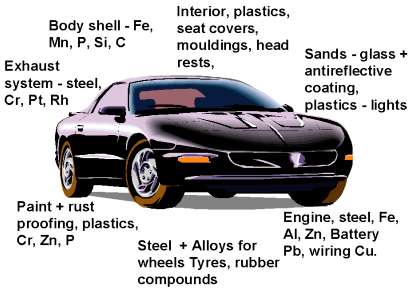| Disposal and Resources |
|
|
Task 5: Before reading any further.
See how many different materials you can list that are used in the manufacture of a car. |
|
Although burning fuel has fairly obvious implications for the environment cars are also extremely "resource intensive", i.e. it takes a lot of energy, water, minerals and manmade chemicals to produce a car. Below are just some of the inputs, you may remember from the Water resources unit that in addition to the compounds below it also takes an estimated 380,000 litres of water to produce 1 car. The body shell is usually produced from Steel, (which is made from iron (Fe)) plus smaller amounts of other minerals such as manganese (Mn), phosphorus (P), silicon (Si) and carbon, (C). The wheels are made from a variety of steel alloys. The parts of electric motors used in the starter mechanism, the windscreen wipers and automatic windows contain iron, steel alloys, aluminium, (Al), zinc, (Zn), etc. Whilst the exhaust system may contain iron, (steel), chrome, and perhaps platinum, Pt or Rhodium (Rh) if it has a catalytic converter. The battery contains lead, (Pb) and the electric wiring copper, (Cu) and aluminium. Window glass is produced from sand, (silica, Si) and there are a whole range of plastic materials (called polymers) produced synthetically from petroleum or naturally from rubbers. These are found in the production of headrests, material covers, seats, tyres, light covers, wiring insulation, etc. Finally, there are the rust resistant protective coatings on both the exterior of the car and various components within it, these use chrome, zinc, aluminium. In addition the paints will include several chemicals, a plastic base, china clay and even powdered slate. You could of course also include the instruction manual which will contain a considerable amount of china clay, which produces the surface of the glossy paper on which it is printed. |

|